Technology Addiction Statistics By Age, Online Gambling, Platform And Effects
Updated · Aug 29, 2024
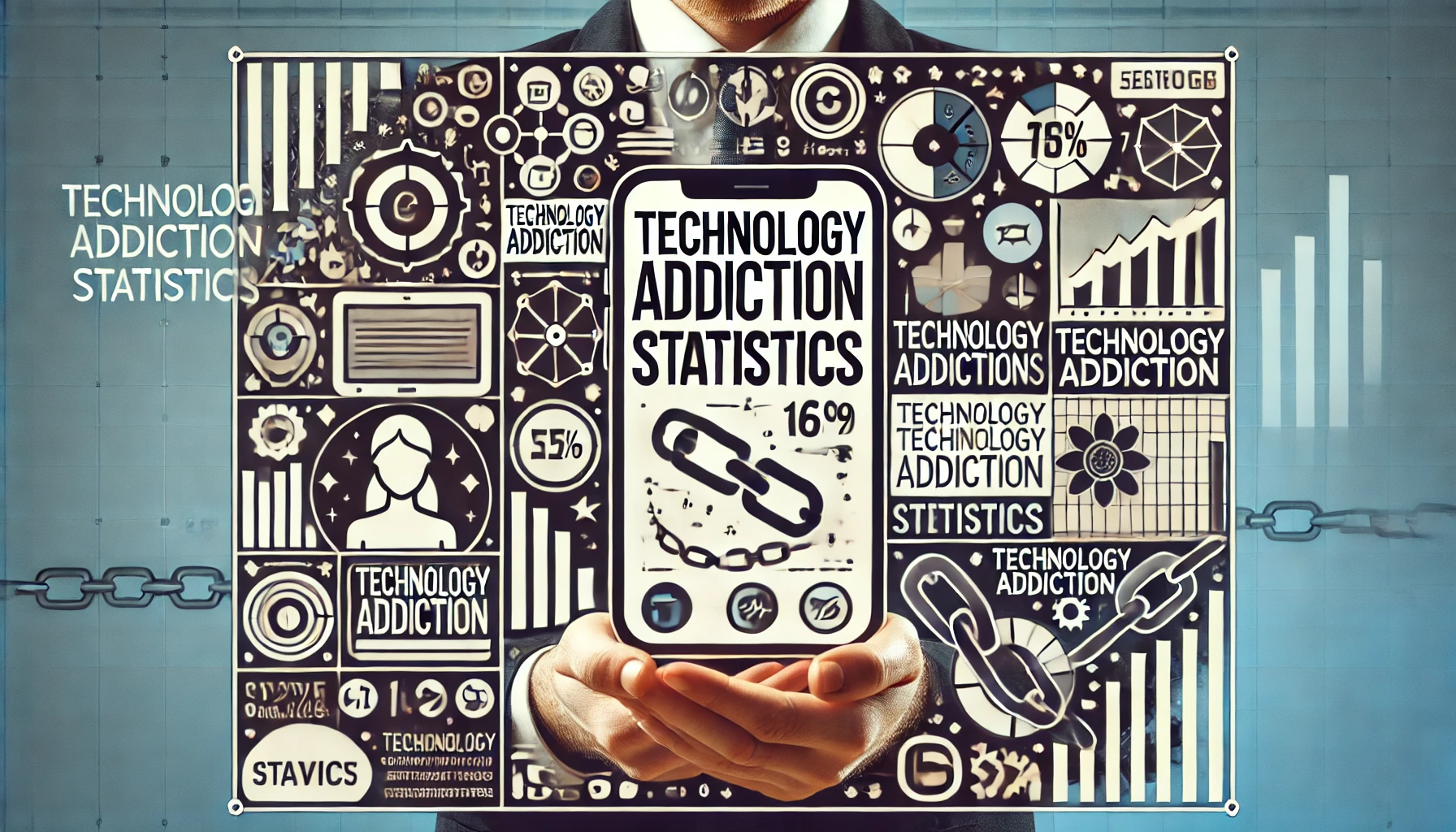
WHAT WE HAVE ON THIS PAGE
- Introduction
- Editor’s Choice
- What is Technology Addiction?
- Symptoms And Signs Of Technology Addiction
- Digital Dependency Statistics
- Technology Addiction By Age
- Online Gambling Addiction Statistics
- Smartphone Addiction Statistics
- Video Game Addiction Statistics
- Social Media Addiction Statistics
- Effects Of Excessive Technology Use Statistics
- Internet Addiction Statistics
- Tips To Stop Technology Addiction
- Conclusion
Introduction
Technology Addiction Statistics: Technology is a big part of our lives today. Thanks to the Internet and smartphones, we can do things that were hard to imagine 50 years ago, like using GPS apps and having video calls. But it’s important to know that spending too much time online can seriously hurt your physical and mental health. People everywhere are constantly using social media, playing video games, watching videos, gambling online, and browsing the web more and more without thinking about how it affects them.
Is technology the most addictive thing out there? Not yet. Tobacco is still the most addictive if we look at how many people use it around the world. However, technology addiction is growing fast, and it might become the most addictive thing in a few years. We shall shed more light on Technology Addiction Statistics through this article.
Editor’s Choice
- Nearly 48% of internet users in the United States think they are addicted or somewhat addicted to their digital devices.
- A study by Vision Direct shows that the average American adult will spend 44 years of their life looking at screens.
- According to a survey, 77% of teenagers feel anxious when they are without their cell phones.
- Over 70% of smartphone users report feeling “phantom vibrations,” where they think their phone is vibrating when it isn’t.
- Technology addiction is linked to more impulsive behavior and less self-control in both kids and adults.
- Excessive tech use can reduce social skills, making face-to-face communication harder.
- Internet addiction is more common among people with existing mental health issues, making their symptoms worse.
- Technology addiction is linked to poor time management and procrastination.
- American adults spend about 24 hours online each week, which adds to the growing issue of tech addiction.
- Technology Addiction Statistics state that Americans check their phones an average of 144 times per day.
- 54% of people prefer spending time on their phones over being with their partner.
- More than half of Americans say they haven’t gone more than 24 hours without their phone.
- According to 31% of parents, screen usage is the third most common cause of arguments between parents and teenagers.
- A Qualtrics survey revealed that 79% of Millennials keep their phones close while they sleep, and 53% wake up at least once a night to check them.
What is Technology Addiction?
Technology addiction is a growing problem in Illinois and everywhere else. As more people rely on technology, the negative effects on mental and physical health are increasing. The numbers are startling: the average person spends almost nine hours a day in front of a screen. Cell phones are unlocked about 150 times a day on average. 72% of teens and nearly half of adults feel the need to reply to texts and notifications right away. Americans check their phones almost 100 times a day, a 20% rise from two years ago. Statistics by different groups also reveal concerning trends.
Technology addiction covers any obsessive behavior related to tech, whether it’s gaming, online shopping, social media, watching videos, or texting. Teenagers are especially at risk, with studies showing 45% are online nearly all the time. This constant use can lead to serious issues like ADHD, anxiety, depression, and even higher risks of suicide.
Addictions to technology and devices can harm both individuals and families. It can negatively impact someone’s job or education as their attention shifts from work or school to digital activities. Technology addiction can also strain relationships and lead to isolation. It often causes problems like insomnia, poor sleep, and increased stress. Common types of technology addictions include gaming, social media, gambling, pornography, online shopping, and work-related activities.
Symptoms And Signs Of Technology Addiction
- Spending more time online than you planned and ignoring other activities shows a need for more control over your tech use.
- Constantly think about being online or checking your device and feel anxious or restless when you can’t.
- Getting irritable, moody, or depressed if you can’t use technology as much as you want.
- Ignoring face-to-face interactions, not keeping up with work, school, or home duties, and avoiding social events because you’re online too much.
- Hiding how much time you spend online or with technology from friends and family and downplaying how serious the issue is.
Digital Dependency Statistics
- That’s about 63% of the global population. Out of these, 3.8 billion have smartphones. It’s tough to avoid becoming a tech addict when so many people have cell phones.
- Even those who weren’t interested now need one to stay connected with family and friends.
- Smartphones have become very popular because they have many apps and features that can keep us looking at screens for hours, as stated by Technology Addiction Statistics.
- It’s not surprising that many people feel they are addicted to technology with so many devices around.
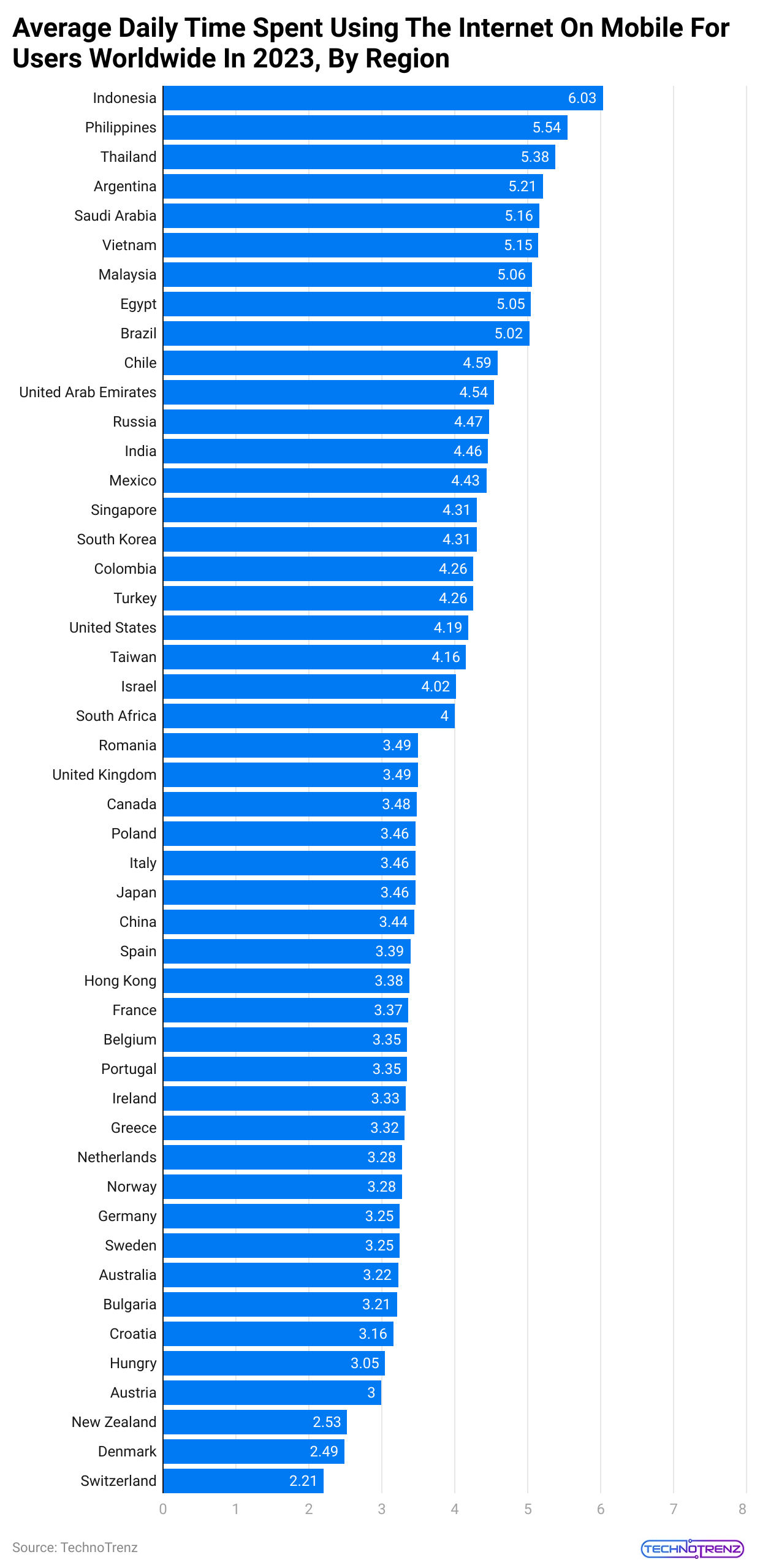
(Reference: sellcell.com)
| Country | Daily Time spent in hours and minutes |
| Switzerland |
2.21 |
|
Denmark |
2.49 |
| New Zealand |
2.53 |
|
Austria |
3 |
| Hungry |
3.05 |
|
Croatia |
3.16 |
| Bulgaria |
3.21 |
|
Australia |
3.22 |
| Sweden |
3.25 |
|
Germany |
3.25 |
| Norway |
3.28 |
|
Netherlands |
3.28 |
| Greece |
3.32 |
|
Ireland |
3.33 |
| Portugal |
3.35 |
|
Belgium |
3.35 |
| France |
3.37 |
|
Hong Kong |
3.38 |
| Spain |
3.39 |
|
China |
3.44 |
| Japan |
3.46 |
|
Italy |
3.46 |
|
Poland |
3.46 |
| Canada |
3.48 |
|
United Kingdom |
3.49 |
| Romania |
3.49 |
|
South Africa |
4 |
| Israel |
4.02 |
|
Taiwan |
4.16 |
| United States |
4.19 |
|
Turkey |
4.26 |
| Colombia |
4.26 |
|
South Korea |
4.31 |
| Mexico |
4.43 |
|
Singapore |
4.31 |
| Russia |
4.47 |
|
India |
4.46 |
| Brazil |
5.02 |
|
Chile |
4.59 |
| United Arab Emirates |
4.54 |
|
Vietnam |
5.15 |
| Malaysia |
5.06 |
|
Egypt |
5.05 |
| Thailand |
5.38 |
|
Argentina |
5.21 |
| Saudi Arabia |
5.16 |
|
Indonesia |
6.03 |
| Philippines |
5.54 |
- According to the chart, Indonesia leads in the amount of time spent on mobile Internet each day. On average, an Indonesian spends 6.03 hours browsing the web on their phone.
- The Philippines is in second place, with people spending an average of 5.54 hours on mobile Internet daily.
- Thailand comes in third, with an average of 5.38 hours spent online through mobile devices.
- In the USA, the average time spent on mobile Internet is 4.19 hours per person.
- The United Kingdom averages 3.49 hours of mobile web use each day.
- The number of households with a computer increased by nearly 20% from 2005 to 2019. With more people working remotely, this number is likely to keep rising.
- eMarketer reports that 36% of people never put down their tech gadgets from January to September 2020.
- Around 25% manage to unplug monthly, while over 30% do so daily. “Unplugging” means not using a device for more than two hours, excluding sleep.
- These figures might shock some people. About 39% of individuals aged 25-39 check their phones daily.
- In contrast, 58% of those 55 and older believe they don’t need to check their phones every day. Women are more likely to be phone addicts (59%) compared to men (41%).
- Despite increasing concerns, 67% of Americans believe phone addiction is a real issue. This is down from 81% in 2018 when more people thought phone addiction was a serious problem.
- Almost 70% of people check their phones right after waking up, and 87% do so within an hour of going to bed.
- Previously, people checked their phones about 47 times a day. Now, the average is 63 times a day.
- According to Technology Addiction Statistics, around 58% of phone users tried to limit their screen time, with 41% of them succeeding.
- Internet use is a major part of our phone usage. About 88% of internet activity in the US involves mobile apps.
- In the UK, about 22% of people think they are addicted to TV, with around 7% being completely sure of their addiction.
- According to Statista, 53% of Americans rely heavily on technology to keep in contact with friends.
- Technology Addiction Statistics state that technology has become deeply integrated into daily life. For instance, 46% of people in the US need it to pay bills, and 35% use it for personal interests and hobbies.
- In 2019, about 32% of internet users were aged 25-34, and 18% were 18-24. Another significant age group for internet use is 35-44, which accounts for 19%.
- The pandemic has increased social media use, with 51% of US adults saying they use it more now. However, only 21% believe they will continue this trend after the pandemic ends.
- In the US, 17% of parents feel they are often distracted by their phones, while 52% think it happens less frequently.
Technology Addiction By Age
- Younger people seem to show more signs of technology addiction compared to older age groups. Let’s examine some data on technology addiction by age.
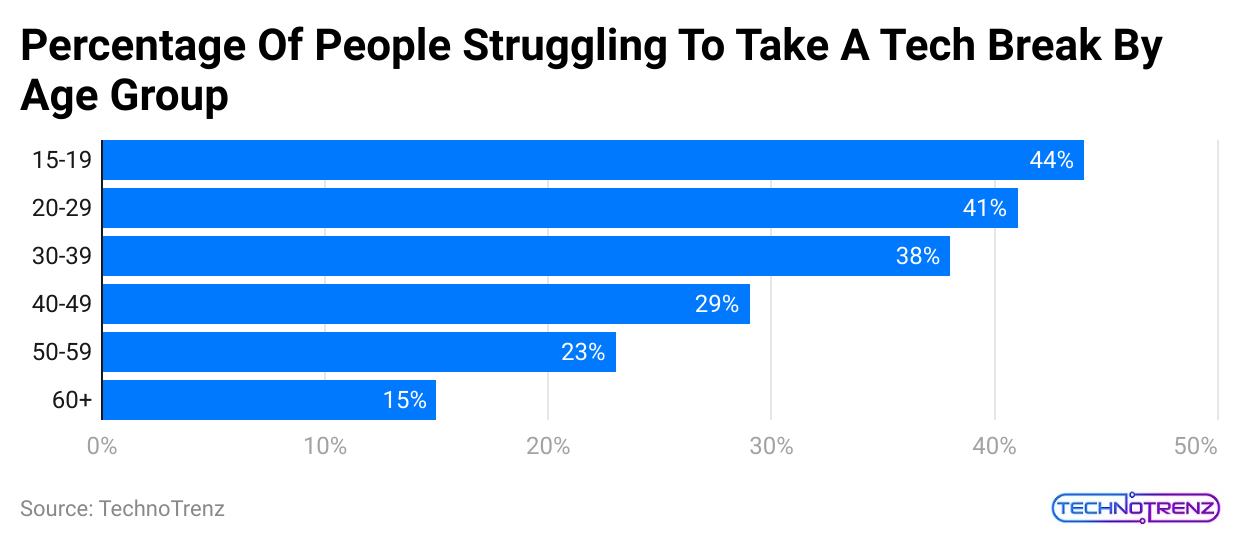
(Reference: sellcell.com)
| Age Group | % |
| 60+ |
15% |
|
50-59 |
23% |
| 40-49 |
29% |
|
30-39 |
38% |
| 20-29 |
41% |
|
15-19 |
44% |
- 44% of people aged 15-19 find it hard to take a break from technology.
- 41% of those aged 20-29 face the same struggle as per Technology Addiction Statistics.
- 38% of individuals aged 30-39 also admit they have trouble stepping away from their devices.
- In the 40-49 age group, 29% report difficulty disconnecting from tech.
- Technology Addiction Statistics stated that almost 23% of people aged 50-59 say they struggle to take tech breaks, and 15% of those aged 60 and older face the same issue.
- The data clearly shows that younger generations are more addicted to technology than older age groups.
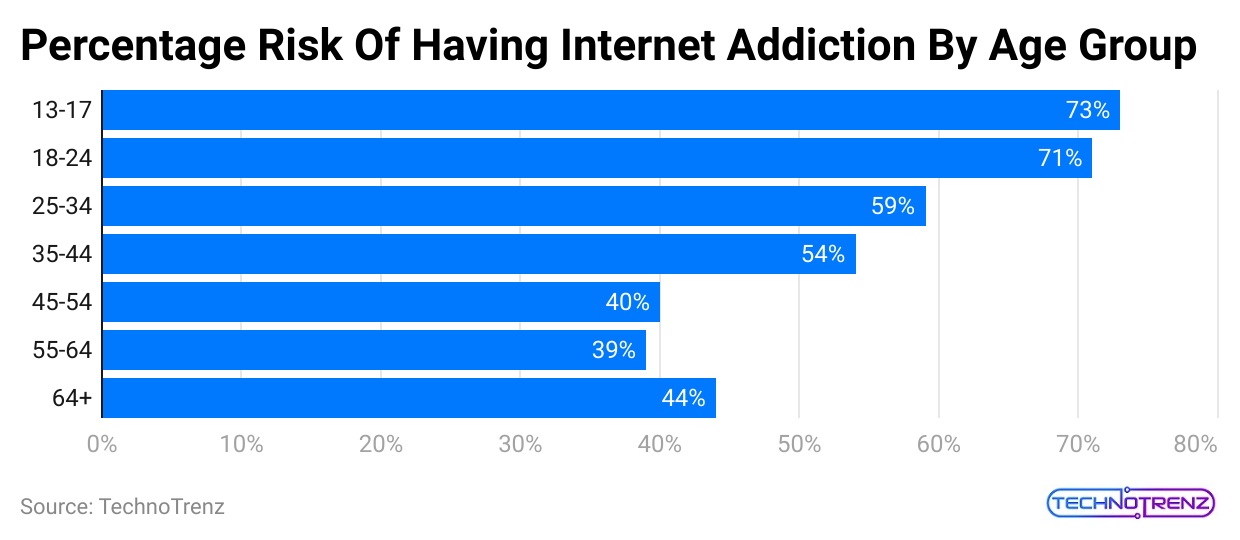
(Reference: sellcell.com)
| Age Group | % |
| 64+ |
44% |
|
55-64 |
39% |
| 45-54 |
40% |
|
35-44 |
54% |
| 25-34 |
59% |
|
18-24 |
71% |
| 13-17 |
73% |
- The data shows that an alarming 73% of 13-17-year-olds are at risk of becoming addicted to the Internet.
- The 18-24 age group is close behind, with 71% at risk of internet addiction.
- For those aged 25-34, 59% are at risk of developing an addiction.
- Technology Addiction Statistics stated that in the 35-44 age group, 54% are also likely to become internet addicts.
- People aged 45-54 and 55-64 have similar addiction risks, with 40% and 39%, respectively.
- The risk slightly increases to 44% for those 64 and older. This may be because many people in this age group are retired and spend more time online at home.
Online Gambling Addiction Statistics
Online gambling can be harmless if enjoyed in moderation. However, for some people, it can lead to serious problems affecting their personal, family, and social lives. Here’s a look at some statistics and facts about online gambling and addiction:
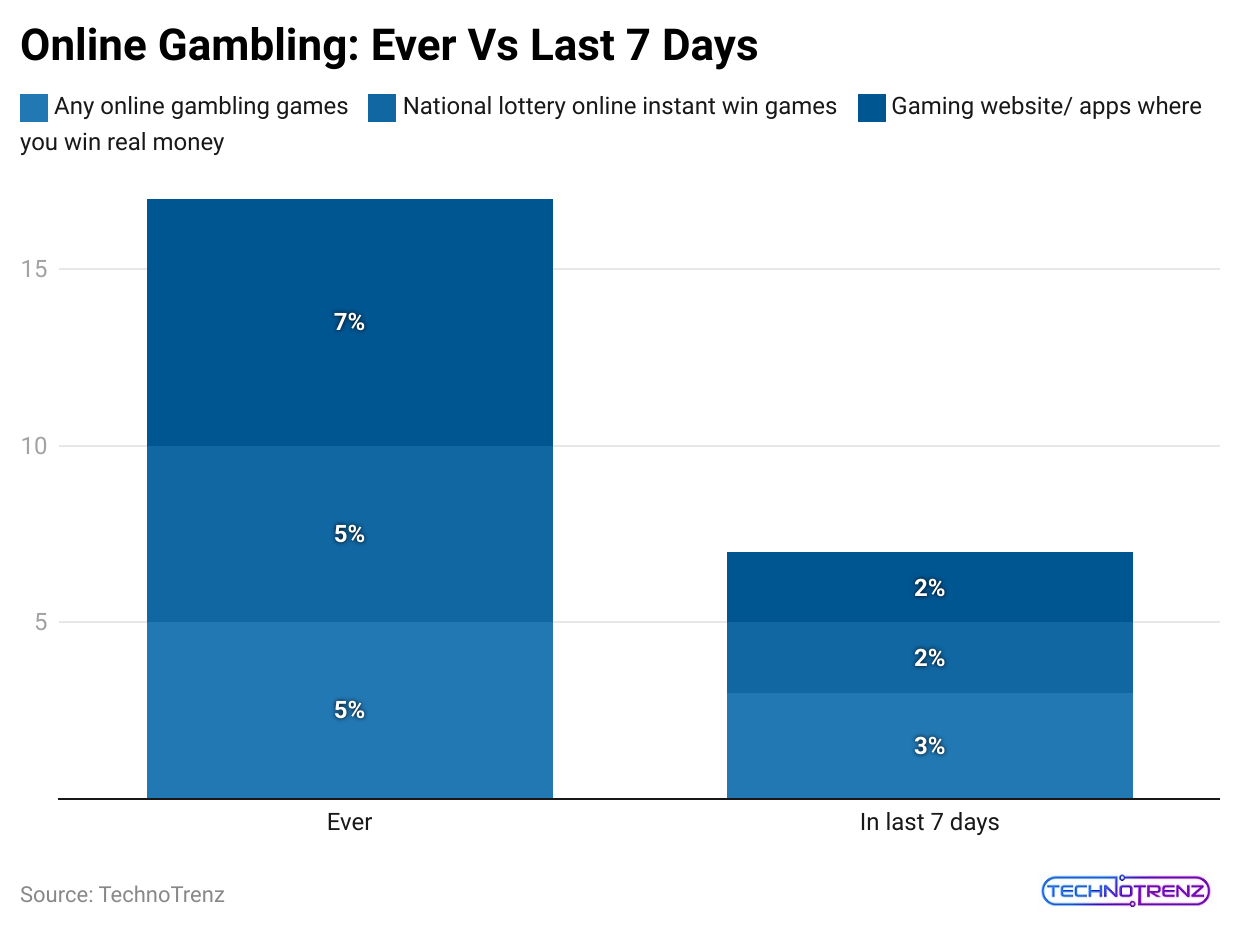 (Reference: financesonline.com)
(Reference: financesonline.com)
- The online gambling industry was worth about $66.7 billion in 2020 and is expected to grow to $92.9 billion by 2027.
- The industry is projected to grow at a rate of 11.5% annually from 2020 to 2027.
- The largest segment, sports betting, was valued at $33.1 billion in 2019 and is estimated to reach $50.2 billion by 2024.
- Casinos were valued at $15.3 billion in 2019, expected to grow to $20.3 billion by 2024.
- Technology Addiction Statistics stated that Poker was valued at $2.7 billion and is expected to reach $2.9 billion.
- About 26% of people worldwide gamble, which is roughly 2.03 billion people. Around 5.3 billion people (67.6%) gamble at least once a year.
- In the UK, 17% of people gamble online, generating £5.3 billion in revenue.
- Online gambling made up 20% of the total gambling revenue in the US in 2020.
- Online gambling saw only a 7% decline during the start of the pandemic in 2020, compared to a 39% decline in retail gambling.
- Technology Addiction Statistics stated that Bingo was at $2.0 billion, with an estimate of $2.2 billion.
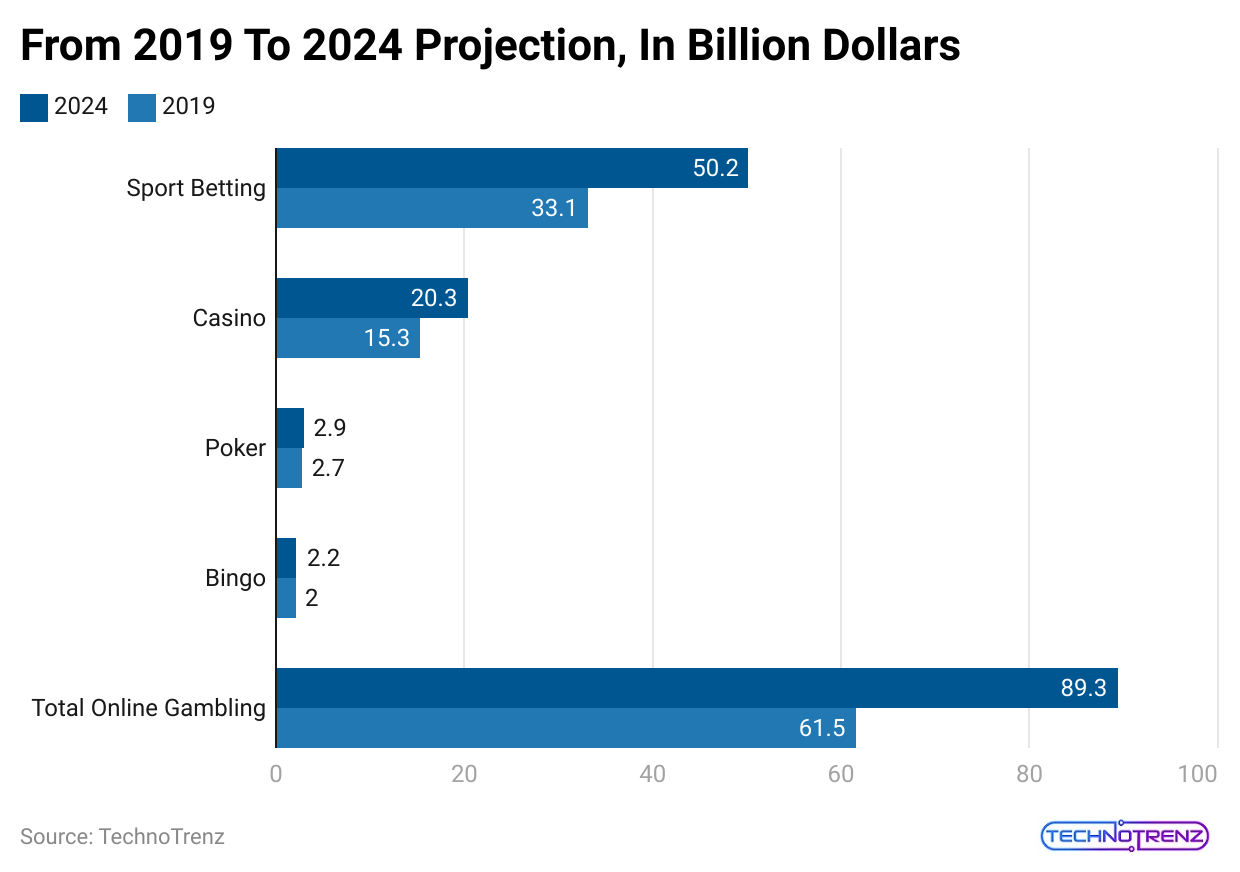 (Reference: financesonline.com)
(Reference: financesonline.com)
Signs of Addiction:
According to the American Psychiatric Association’s DSM-5, signs of online gambling addiction include:
- Feeling the need to hide gambling.
- Constantly thinking about gambling, planning the next session, or finding money to gamble.
- Trying but failing to control gambling.
- Feeling excitement from big bets.
- Using gambling to escape problems or relieve negative feelings.
- Justifying gambling as a way to recover lost money.
- Concern from family and friends about gambling.
- Spending increasing amounts of money to get the same excitement.
- Gambling despite having little money or accumulating debts.
- Irritability when not gambling.
- Continuing to gamble despite losses.
- Lying to hide the extent of gambling.
- Having other mood or behavior disorders.
- Damaging relationships, jobs, or education due to gambling.
- Relying on others for money because of gambling.
- Stealing to fund gambling.
Smartphone Addiction Statistics
- According to Technology Addiction Statistics, in 2022, 86% of people used their smartphones to go online, up from 28% in 2009. This sharp increase likely contributes to the growing addiction to smartphones.
- uSwitch also notes that as of 2023, half of all nine-year-olds in the UK own a smartphone.
- Young people are more susceptible to smartphone addiction, so this statistic is concerning for society’s youngest and most impressionable members.
- Generation Z is the most likely generation to be addicted to smartphones. About 75% of Gen Z individuals say they spend too much time on their phones.
- Teens who spend over five hours a day on their smartphones are 71% more likely to show suicidal tendencies compared to those who use their phones for just one hour a day.
(Reference: sellcell.com)
| Very frequently | Fairly frequently | Not very frequently | Never | |
| While you’re driving | 1% | 3% | 12% |
84% |
|
When you wake up in the middle of the night |
5% | 12% | 29% | 54% |
| While eating dinner out with others | 2% | 9% | 43% |
46% |
|
While having dinner at home |
3% | 15% | 36% | 46% |
| While in bed before going to sleep | 21% | 22% | 23% |
34% |
|
While working |
8% | 27% | 39% | 26% |
|
While watching TV |
17% | 37% | 32% |
14% |
- 17% of people often check their smartphones while watching TV, while 14% don’t use their phones during TV time.
- 8% of people frequently check their smartphones at work, 27% check it somewhat often, 39% check it occasionally, and 26% do not check their phones at work.
- Technology Addiction Statistics stated that almost 21% of people often check their smartphones before going to bed.
- 84% of people say they never check their phones while driving, which is good because texting while driving can be dangerous and cause accidents.
- 3% of people often use their phones during dinner at home, and 2% do the same when eating out with others, which can harm our relationships.
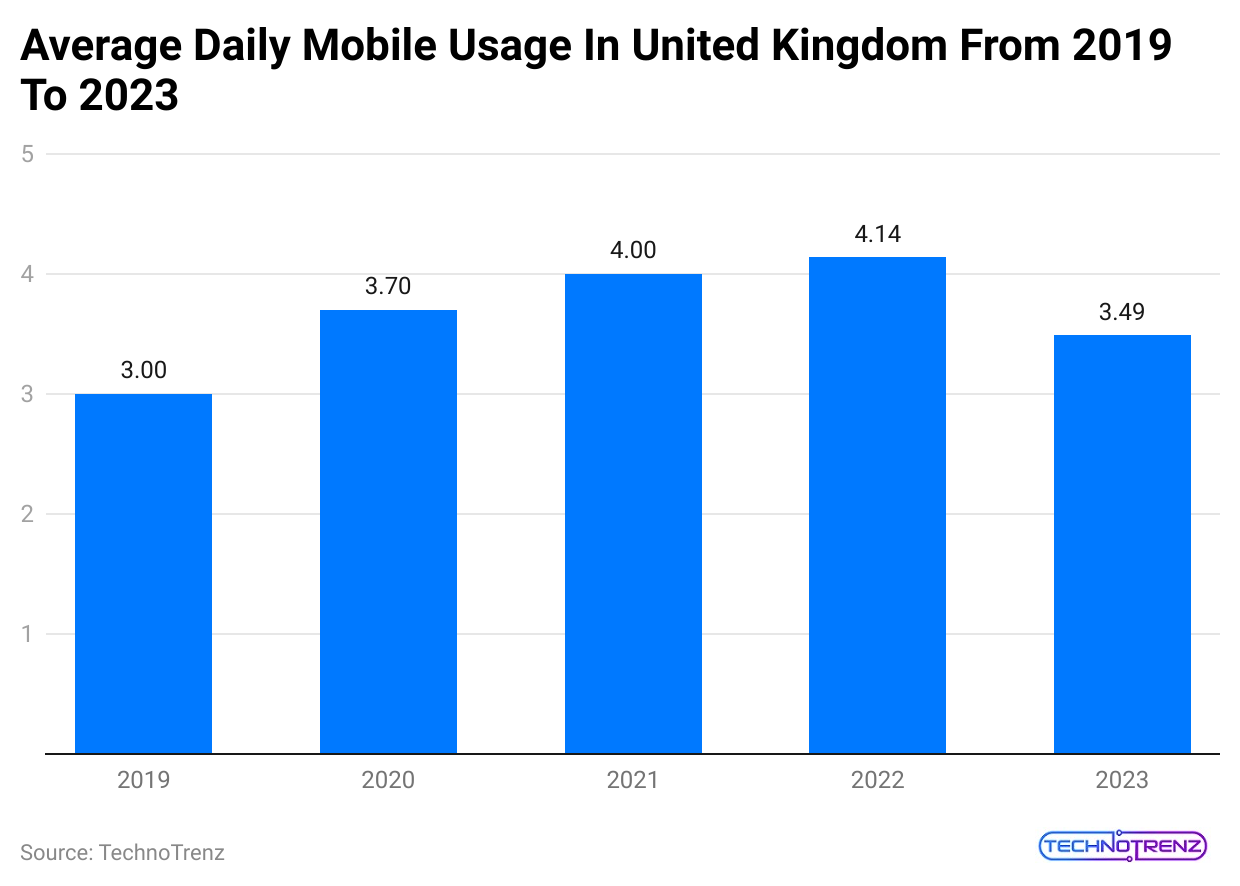
(Reference: sellcell.com)
| Daily average hours | |
| 2023 |
3.49 |
|
2022 |
4.14 |
| 2021 |
4 |
|
2020 |
3.7 |
| 2019 |
3 |
- Technology Addiction Statistics stated that almost 5% of people frequently check their phones if they wake up in the middle of the night.
- The most common use of smartphones is for chatting and sending messages, with 74.7% of people using their phones mainly for this purpose.
- Among millennials, 36% spend two or more hours of their workday looking at their phones, playing games, using social media, or messaging friends.
- In the UK, 46% of parents admit to having some level of smartphone addiction. For those aged 46-55 in the UK, 20% say WhatsApp is the social media app they couldn’t live without.
- 33% of teens spend more time on their smartphones than interacting with friends and family face-to-face. Even when with friends or family, 52% of teens will often sit quietly for long periods while focusing on their smartphones.
- In the US, 47% of people say their smartphones negatively affect their mental and emotional well-being. Additionally, 51% believe their phones harm their physical health.
- Technology Addiction Statistics stated that around 54.7% of smartphone owners report experiencing eye strain from using their phones.
- On average, a person will spend five years and four months on social media over their lifetime.
- According to Technology Addiction Statistics, American smartphone users typically pick up their phones about 352 times a day or more.
- 75% of smartphone owners admit to texting while driving at least once. 27% of US smartphone owners say they’ve sent text messages while stopped at traffic lights.
- 48% of people experience nomophobia, or the fear of being without their phone, when their battery level drops to 20%.
Video Game Addiction Statistics
- The World Health Organization now officially recognizes gaming addiction as a real disease.
- On average, a typical gamer spends about 6 hours and 20 minutes a week playing video games. However, people with gaming addiction can spend 80 to 100 hours in the same period.
- As per Technology Addiction Statistics, there are around 3.09 billion active gamers in 2023.
| Year | Number of active video game players globally |
| 2015 |
2.03 billion |
|
2016 |
2.17 billion |
| 2017 |
2.33 billion |
|
2018 |
2.49 billion |
| 2019 |
2.64 billion |
|
2020 |
2.81 billion |
| 2021 |
2.98 billion |
|
2022 |
3.09 billion |
| 2023 |
3.22 billion |
|
2024 |
3.32 billion |
- 2 billion people, or 40% of the global population, play video games. Out of these, at least 105.6 million are considered addicted to gaming.
- In the US, 8.5% of teenage gamers show signs of addiction to video games.
- Technology Addiction Statistics stated that almost 94% of video game addicts are male, and 69% of them are white.
- According to reviews, Rocket League is the most addictive game, and the “social simulation” genre is the most likely to cause addiction.
- Gamers in China spend over 12 hours per week playing video games, while gamers in the US spend nearly 8 hours per week.
- Gamers who are deeply involved in their games often give up other hobbies or relationships to keep playing.
- Gaming addiction can also start affecting their real-life activities.
- Smartphone addiction is often linked to gaming addiction because mobile phones have many gaming apps.
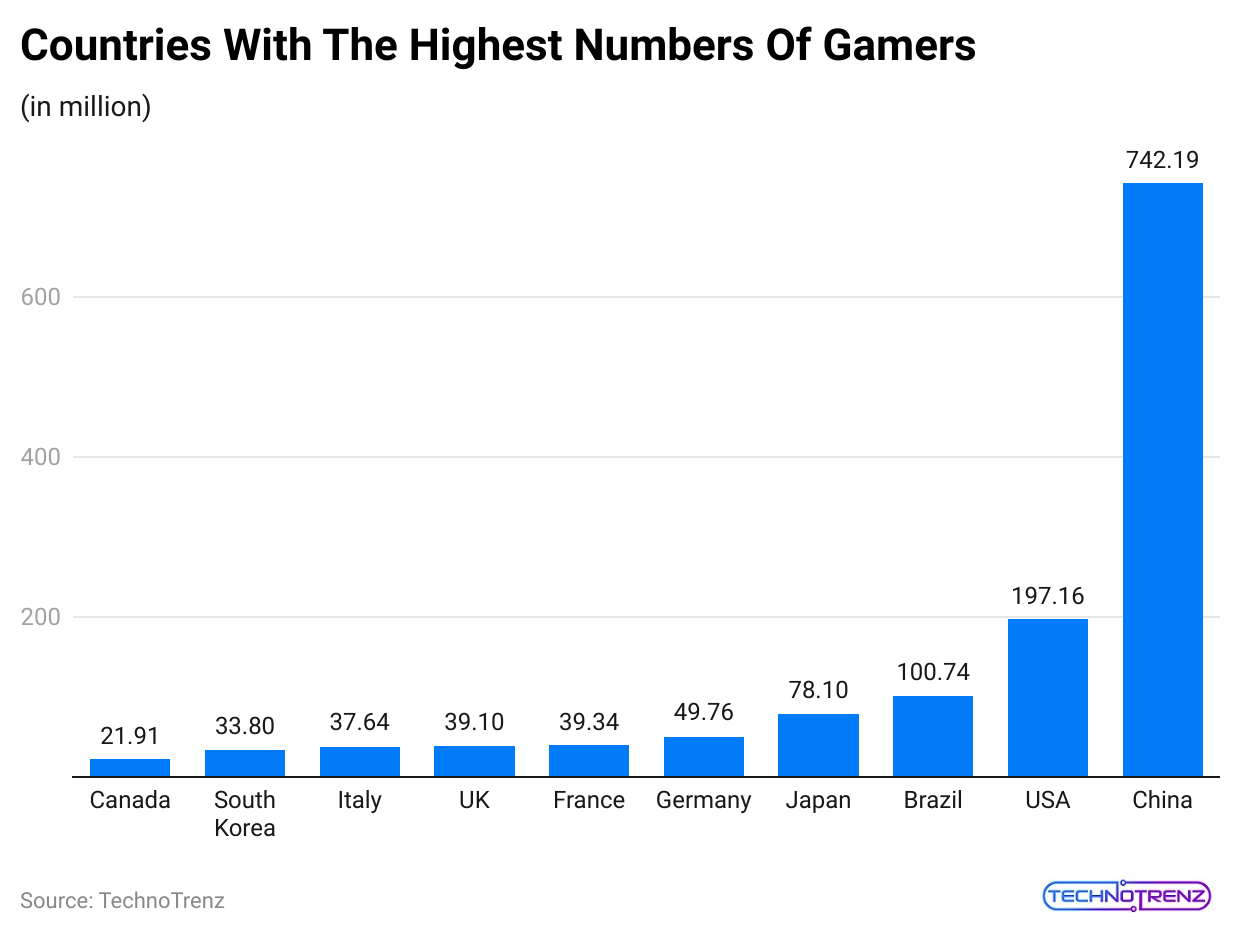
(Reference: headphonesaddict.com)
| Country | Number of video gamers |
| China |
742.19 million |
|
USA |
197.16 million |
| Brazil |
100.74 million |
|
Japan |
78.1 million |
| Germany |
49.76 million |
|
France |
39.34 million |
| UK |
39.1 million |
|
Italy |
37.64 million |
| South Korea |
33.8 million |
|
Canada |
21.91 million |
- About 76% of people prefer playing games on their mobile phones.
- Around 83% of teenage girls and 97% of teenage boys play video games. On average, gamers play for 7 hours and 7 minutes each week.
- Hardcore gamers play much more. Male gamers average 4 hours and 43 minutes per session, while female gamers average 4 hours and 23 minutes.
- Gamers aged 26-35 are the most dedicated, playing about 8 hours and 13 minutes weekly.
- Men generally play more than women. Men average 7 hours and 53 minutes per week, while women average 6 hours and 17 minutes.
- Gamers spend an average of 2.01 hours on their mobile phones, 1.59 hours on computers, 1.25 hours on gaming consoles, and 1.04 hours on tablets each day.
- About 47% of parents think their teenage boys spend too much time playing video games, while only 11% feel the same about teenage girls.
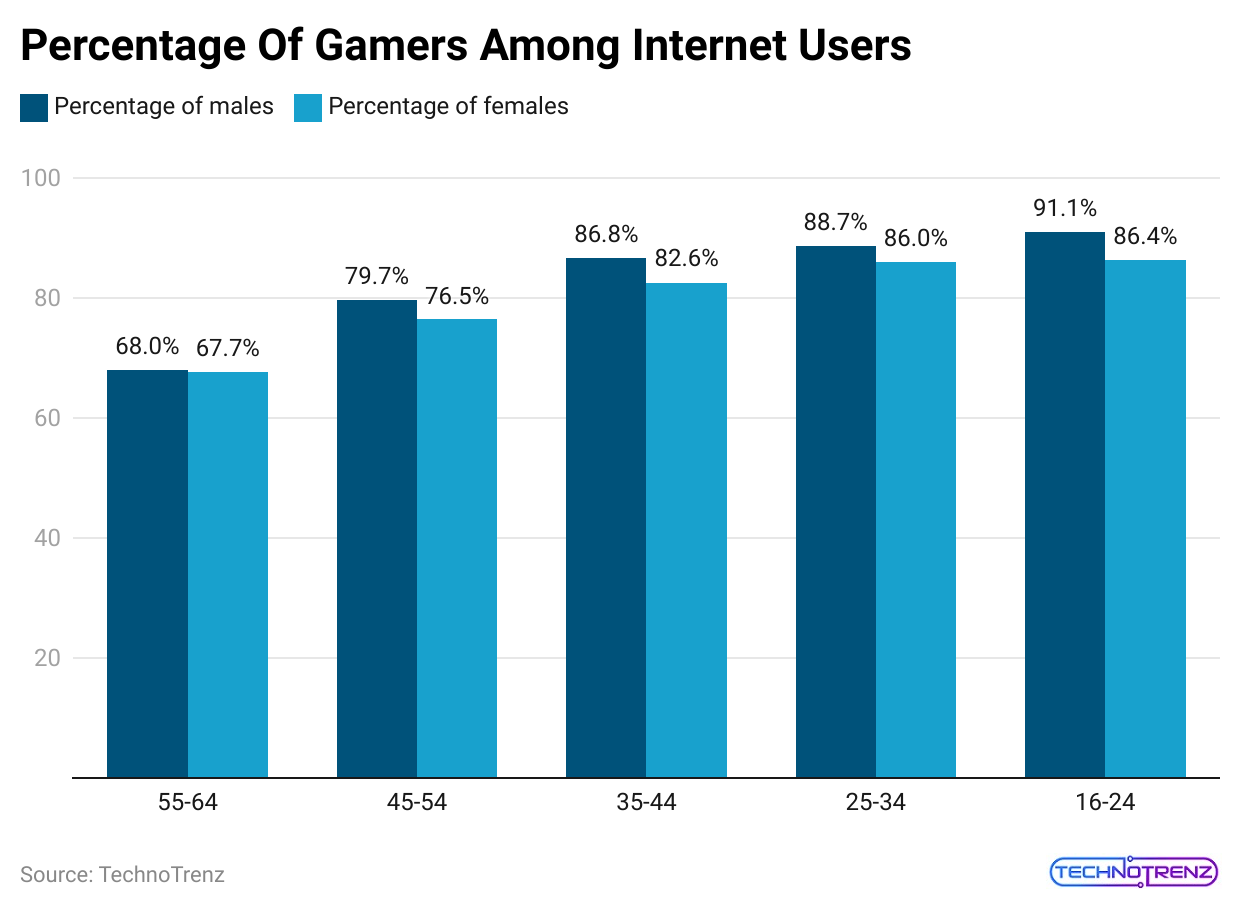
(Reference: headphonesaddict.com)
| Age Group | % of males | % of females |
| 55-64 | 68% |
67.7% |
|
45-54 |
79.7% | 76.5% |
| 35-44 | 86.8% |
82.6% |
|
25-34 |
88.7% | 86% |
| 16-24 | 91.1% |
86.4% |
- Hardcore male gamers typically own about 80 games, while hardcore female gamers own around 64. Men often buy an average of 5 new games, compared to 2.67 new games for women.
- There are around 2.7 billion gamers worldwide. Many adolescents prefer playing video games over reading, homework, or participating in sports and physical activities.
- On average, gamers spend about 1 hour and 6 minutes playing games each day, which adds up to 7 hours and 42 minutes per week and 30 hours and 48 minutes per month.
- It’s important to distinguish between leisure and addiction.
- Technology Addiction Statistics stated that Leisure activities, like gaming in moderation, can be enjoyable and reduce stress.
- Addiction, however, increases stress and can lead to negative impacts on your life.
- Be mindful of your priorities and choose activities that enhance your life without leading to addiction.
Social Media Addiction Statistics
- 40% of American internet users aged 18 to 22 say they are addicted to social media.
- 5% of people aged 18 to 22 feel that saying “I am addicted to social media” describes them perfectly.
- Over 70% of adults in countries like the Philippines, Malaysia, South Africa, and Kenya use social media to get their news.
- In the US, 34% of women who use the Internet feel addicted to social media.
- 11% of these women think the phrase “I am addicted to social media” perfectly describes them.
- People from lower-income backgrounds might be more likely to have problems with social media use.
- Technology Addiction Statistics stated that around 55% of drivers in the US admit to using social media while driving.
- Research shows that getting “likes” on social media activates the same brain areas in teens as getting money or eating chocolate.
- Frequent social media use can rewire a teen’s brain always to seek immediate pleasure, leading to other addictive behaviors.
- In the UK, 48% of social media users aged 16 to 18 feel addicted to social media.
- 57% of teenage girls feel addicted to social media, while 37% of teenage boys feel the same way.
Effects Of Excessive Technology Use Statistics
- The average American adult spends over 11 hours a day using electronic devices.
- Studies show that too much screen time can cause changes in brain function, similar to addiction to substances.
- Research suggests that being addicted to technology can increase the risk of mental health issues like depression and anxiety.
- A survey found that 94% of parents believe their kids spend too much time on screens.
- Excessive use of technology can lead to sleep problems and insomnia for both adults and children.
- The constant urge to check notifications on smartphones can create a state of always being “on.”
- Using technology too much can hurt face-to-face communication skills in kids and young adults.
- Teenagers who use electronic devices for more than 5 hours a day are more likely to have suicidal thoughts.
- Technology addiction can decrease attention span and make it harder to focus.
- Excessive screen time is linked to obesity in kids and teens.
- The blue light from screens can disrupt sleep by affecting melatonin production.
- Addiction to technology is associated with feelings of loneliness and social isolation.
- Americans check their phones about 96 times a day, which leads to frequent distractions and lower productivity.
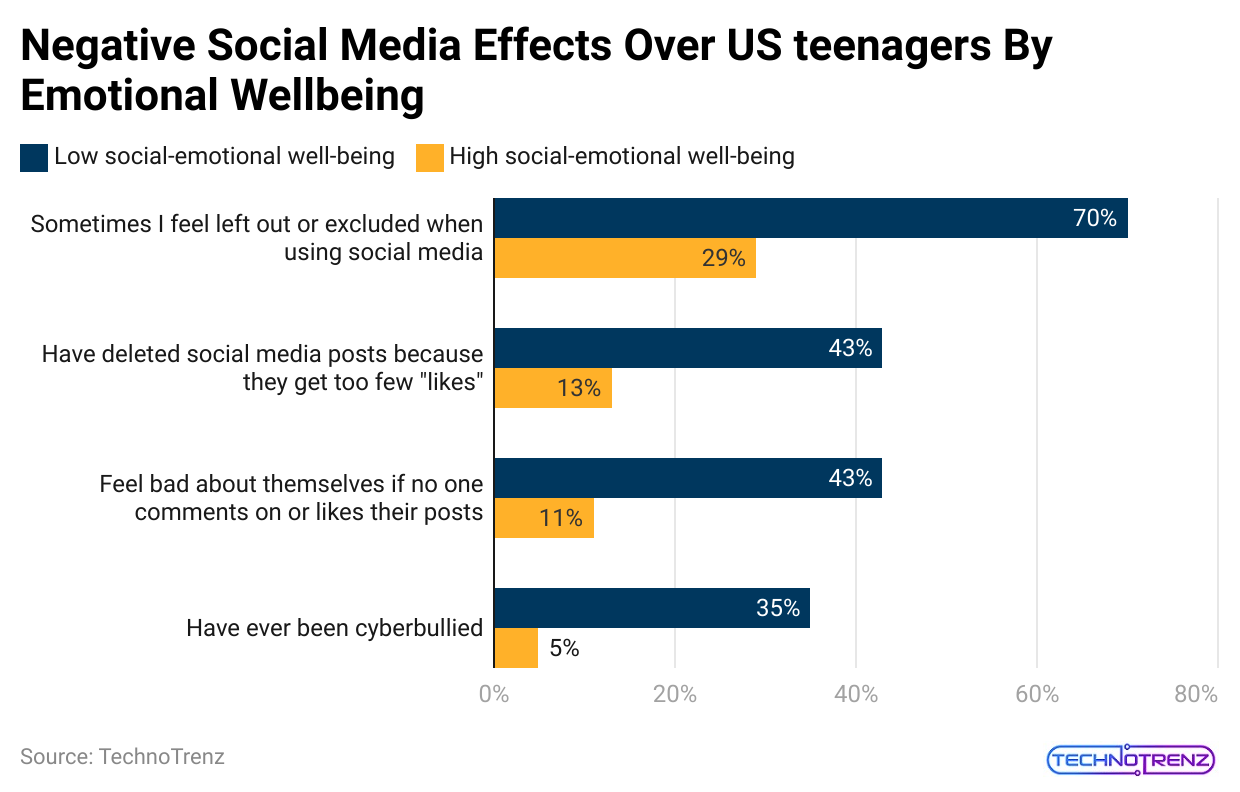
(Reference: truelist.co)
- Excessive social media use is connected to increased feelings of envy, depression, and low self-esteem.
- Over 50% of car accidents involving teens are due to distracted driving, often from smartphone use.
- Technology addiction can cause physical problems like “text neck” and eye strain from long screen time.
- On average, adults spend over two hours a day on social media, affecting real-life social interactions.
- Research shows that heavy smartphone use is linked to lower empathy and emotional intelligence.
- Technology Addiction Statistics stated that video game addiction can result in poor grades, social withdrawal, and family issues.
- Kids who spend more than 2 hours a day on screens are more likely to have language delays.
- More than 40% of adults feel anxious if their phone battery is low or if they can’t find their phone.
- Technology addiction is linked to impulsive behavior and difficulty regulating oneself in both kids and adults.
- The digital detox industry is expected to reach over $2 billion by 2023 as people look for ways to unplug.
- Technology addiction can reduce physical activity and outdoor play, leading to sedentary lifestyles in both kids and adults.
- Research indicates that technology addiction may alter brain chemistry, affecting dopamine levels and reward pathways.
- Excessive social media use is associated with loneliness and social isolation.
- About 33% of teenagers experience cyberbullying, which increases stress and anxiety.
- The average person spends about 6 hours and 42 minutes online each day, contributing to tech addiction.
- Technology addiction is linked to sleep problems and an increase in sleep disorders.
- Using digital devices before bed is connected to poorer sleep quality and more insomnia.
- Technology addiction can lower academic performance as distractions from screens affect students’ focus.
- Excessive technology use has been linked to reduced face-to-face social interactions, which can affect personal relationships, as stated in Technology Addiction Statistics.
- The average American spends over 10 hours a day consuming media, worsening technology addiction issues.
- Too much screen time is linked to poor social skills development in children, affecting their communication abilities.
- Technology addiction can reduce emotional intelligence as people rely more on screens than face-to-face interactions.
- Teenagers typically send and receive around 100 text messages a day, adding to their screen time.
- Technology addiction can lead to lower physical activity levels, contributing to sedentary lifestyles and health risks.
- Social media addiction has increased recently, with many users experiencing negative effects.
- Technology addiction affects decision-making and impulse control, leading to risky behaviour.
- Excessive social media use can cause sleep disturbances and poor sleep quality.
Internet Addiction Statistics
- About 13.7% of people addicted to the Internet find it hard to stay offline for several days.
- Around 12.4% of internet users regularly or frequently spend more time online than they planned.
- The average person spends 6 hours and 42 minutes online each day.
- Another study found that 4.1% of students are internet addicts, while 28.5% are at risk of becoming addicted.
- In the Philippines, people spend an average of 8.52 hours online each day.
- Technology Addiction Statistics state that about 40% of people have a compulsive disorder related to internet use.
- The International Journal of Neuropsychiatric Medicine reports that roughly 1 in 8 Americans has problematic internet use, with rates reaching up to 30% in some countries.
- According to Technology Addiction Statistics, South Africa is the most internet-addicted country, with people spending at least 9.5 hours online daily.
- Brazil, the Philippines, Argentina, and Colombia also have high internet addiction rates.
- In Malaysia, 34% of people of Chinese descent admitted to being addicted to the Internet.
Tips To Stop Technology Addiction
After sharing all these concerning statistics, here are some simple tips to help break or prevent technology addiction:
- Digital Detox – Limit your screen time. Start with small reductions and gradually decrease until you reach your target.
- Outdoor Activities – Spend time outside to distract yourself from technology. Try swimming, biking, hiking, or any activity that doesn’t involve screens.
- Tech-Free Zone – Set up an area in your home where technology isn’t allowed. Use this space to read books, talk with family and friends, or play games.
- Turn on Airplane Mode at Night – Set your phone to airplane mode before bed to avoid being disturbed by notifications and focus on getting a good night’s sleep.
- Use Apps to Limit Phone Use—It may seem counterintuitive, but using apps designed to limit phone use can help you manage your screen time.
- Reward Yourself—Reward yourself for staying away from technology. Make sure the reward is non-digital.
Conclusion
Things have changed a lot in recent years regarding technology use. The facts about technology addiction show this clearly. While technology has made our lives more efficient and convenient, it has also had both positive and negative effects.
Ultimately, it’s up to each person to manage how they use their devices and the impact of the Internet on their lives. This article sheds enough light on the statistics on technology addiction.
Sources
FAQ.
-26.99% of people around the world are addicted to their smartphones.
– 17.42% of the global population is addicted to social media.
– 14.22% of people worldwide are addicted to the Internet.
– 8.23% of people globally are addicted to cybersex.
Over 50% of Americans feel they are addicted to their phones. Research shows that about 35% of people are addicted to the Internet. Up to 60% of teens show signs of cell phone addiction. At least 10% of Americans using social media are addicted to it.

After graduating in Electrical Engineering, Maitrayee moved into writing after working in various technical roles. She specializes in technology and Artificial Intelligence and has worked as an Academic Research Analyst and Freelance Writer, focusing on education and healthcare in Australia. Writing and painting have been her passions since childhood, which led her to become a full-time writer. Maitrayee also runs a cooking YouTube channel.





